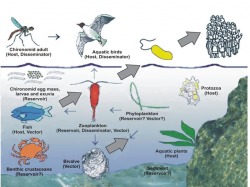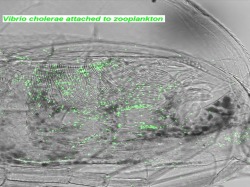Luigi Vezzulli è titolare dei seguenti insegnamenti presso la Facoltà di Scienze Matematiche, Fisiche e Naturali dell’Università degli Studi di Genova (http://www.unige.it/)

Environmental Biochemistry and Microbiology (Biochimica e Microbiologia Ambientale)
Modulo “Microbiologia Ambientale”
Corso di Laurea in Scienze Ambientali
sito internet http://www.laureestan.unige.it/sito/?p=34
Settore: BIO19
Crediti: 5
The composition of the microbial world. Comparison between eukaryotes and prokaryotes. Structural and functional characteristics of the bacterial cell. The bacterial division. Nutritional classes of bacteria and energy reactions. The growth curve; effect of the environment on bacterial growth; survival strategies of bacteria at stress. The endospore. Main features of gene exchanges in bacteria and their study in the marine environment. Genetics of microorganisms, horizontal gene transfer (conjugation, transduction, transformation). Archea: classification, main characteristics and ecological role. Virus: main features (structure and replication cycle); lytic cycle and lysogenic cycle of bacteriophages. Viruses in the environment, biology, ecology and techniques for their detection. General characteristics of eukaryotic microorganisms. Sterilization techniques. Cultures and non-culture surveys for the study of presence, concentration and activity of microbes in the environment. Ecological role of microorganisms: biogeochemical cycles, microbial metabolism. Microbial biofilms.
Modulo “Microbiologia Ambientale”
Corso di Laurea in Scienze Ambientali
sito internet http://www.laureestan.unige.it/sito/?p=34
Settore: BIO19
Crediti: 5
The composition of the microbial world. Comparison between eukaryotes and prokaryotes. Structural and functional characteristics of the bacterial cell. The bacterial division. Nutritional classes of bacteria and energy reactions. The growth curve; effect of the environment on bacterial growth; survival strategies of bacteria at stress. The endospore. Main features of gene exchanges in bacteria and their study in the marine environment. Genetics of microorganisms, horizontal gene transfer (conjugation, transduction, transformation). Archea: classification, main characteristics and ecological role. Virus: main features (structure and replication cycle); lytic cycle and lysogenic cycle of bacteriophages. Viruses in the environment, biology, ecology and techniques for their detection. General characteristics of eukaryotic microorganisms. Sterilization techniques. Cultures and non-culture surveys for the study of presence, concentration and activity of microbes in the environment. Ecological role of microorganisms: biogeochemical cycles, microbial metabolism. Microbial biofilms.

Marine Microbiology (Microbiologia Marina)
Corso di Laurea Magistrale in Biologia ed Ecologia Marina
sito internet http://www.biologia.unige.it/
Settore: BIO19
Crediti: 6
The main groups of marine microorganisms: taxonomic classification, biological characteristics, phototrophic bacteria, chemoautotrophic bacteria, extremophiles marine prokaryotes, marine viruses. Role of microorganisms in the marine environment: microbial loop, viral loop, biological pump. Marine pathogenic microorganisms: infections transmitted to humans and animals and main biological characteristics of some of the pathogens involved (e.g. Vibrio spp.). Physiological status and survival strategies of bacteria in the marine environment: state of "starvation", state VBNC, microbial biofilms. Culture-based (traditional assays and in situ cultivation) and non culture- based (PCR, epifluorescence microscopy, fluorescent in situ-FISH hybridization, antigen antibody reactions) assays for the detection and study of bacteria and viruses in marine samples. Analysis of microbial diversity in the marine environment: molecular fingerprinting techniques (ARDRA, RLFP, TRLFP, DDGE, TTGE), metagenomic techniques (amplicon-based metagenomic, shotgun metagenomic, target-based metagenomic). Climate change and marine microrganisms. Faecal pollution and microbiological control of marine waters. Biotechnological use of marine microorganisms and their products.
References
-Michael T. Madigan BROCK-Biologia dei Microrganismi (Volume 1, 2A)
Altri testi consigliati:
-Perry Microbiologia. Vol. 2: Ecologia, microbiologia medica, microbiologia applicata. Zanichelli
-Barbieri, Bestetti, Galli e Zannoni. Microbiologia ambientale ed elementi di ecologia microbica. Casa Editrice Ambrosiana
Corso di Laurea Magistrale in Biologia ed Ecologia Marina
sito internet http://www.biologia.unige.it/
Settore: BIO19
Crediti: 6
The main groups of marine microorganisms: taxonomic classification, biological characteristics, phototrophic bacteria, chemoautotrophic bacteria, extremophiles marine prokaryotes, marine viruses. Role of microorganisms in the marine environment: microbial loop, viral loop, biological pump. Marine pathogenic microorganisms: infections transmitted to humans and animals and main biological characteristics of some of the pathogens involved (e.g. Vibrio spp.). Physiological status and survival strategies of bacteria in the marine environment: state of "starvation", state VBNC, microbial biofilms. Culture-based (traditional assays and in situ cultivation) and non culture- based (PCR, epifluorescence microscopy, fluorescent in situ-FISH hybridization, antigen antibody reactions) assays for the detection and study of bacteria and viruses in marine samples. Analysis of microbial diversity in the marine environment: molecular fingerprinting techniques (ARDRA, RLFP, TRLFP, DDGE, TTGE), metagenomic techniques (amplicon-based metagenomic, shotgun metagenomic, target-based metagenomic). Climate change and marine microrganisms. Faecal pollution and microbiological control of marine waters. Biotechnological use of marine microorganisms and their products.
References
-Michael T. Madigan BROCK-Biologia dei Microrganismi (Volume 1, 2A)
Altri testi consigliati:
-Perry Microbiologia. Vol. 2: Ecologia, microbiologia medica, microbiologia applicata. Zanichelli
-Barbieri, Bestetti, Galli e Zannoni. Microbiologia ambientale ed elementi di ecologia microbica. Casa Editrice Ambrosiana
